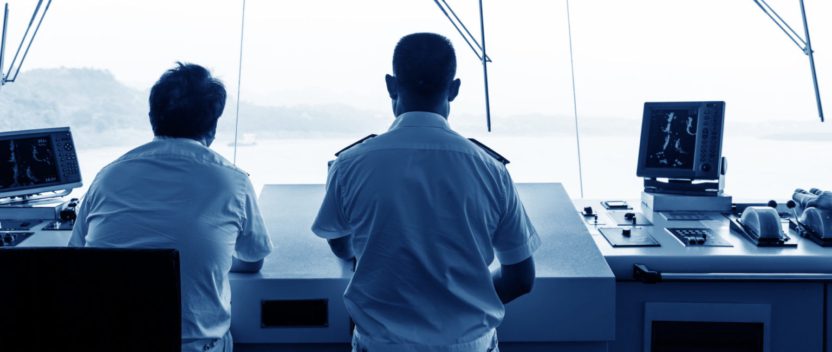Paperwork and data futures under discussion
We’ve been keeping an eye on the news agenda during what has been a busy start to the year and rounding up major stories that made headlines this month. Paperwork continues to be a bone of contention, whether onboard ship or ashore but owners seem to place varying values on it. New shipping routes are emerging but there are fears that the EU could finally impose a ban on Filipino seafarers. A leading analyst says shipping’s infatuation with size is running out of steam and meanwhile a dangerous cargo is washing up on UK beaches…
Key speakers at the recent China Maritime event gave some stark perspectives on the problems facing seafarers and their landside colleagues, but also posited some solutions too, Seatrade Asia Week reported.
Anglo Eastern managing director of QHSE and Training Pradeep Chawla told the event that in 1982 there were just 30 IMO conventions in force while crew numbers averaged 50 per vessel. In 2014, there are more than 60 conventions in force while crew numbers have dropped to between 18 to 20, effectively doubling the paper workload while halving crew numbers.
He also cited a study by the Danish Maritime Authority which found that Danish seafarers were using up to 20% of their time on tasks they deemed as administrative burdens, a figure that was just 9% among workers in land-based offices.
The shipping industry’s error he said was failing to learn from other industries which had outsourced repetitive tasks. Modern communications he said enabled many of these tasks to be delegated ashore, a call echoed by Inmarsat Maritime President Frank Coles who acknowledged that “ship to shore connectivity has not kept pace with the unprecedented data access available ashore after the internet revolution. The industrial internet is here and shipping will have to accept it.”
A market in non-compliance?
With less than a year to go before the sulfur limit in Emission Control Areas falls to 0.1%, the Danish Shipowners’ Association has warned that owners are failing to factor higher fuel costs into future freight rates.
This suggests that they either believe non-compliance with ECA rules is a risk worth taking or that they are prepared to swallow the cost of low sulfur fuel, which could be double that of heavy fuel oil.
The rules mean that owners must choose whether to use more costly distillate fuel, spend millions of dollars installing an exhaust-gas cleaning scrubber or converting the vessel to run off liquefied natural gas. Even though the regulations will apply equally to all ships that operate in an ECA, the DSA suspects that some owners are planning to ignore the rules.
Lloyd’s List reported that the Association has warned the Danish government that some of its members are already missing out on forward cargoes for 2015 because some quoted rates are uncompetitive compared to other operators. This, the DSA suggests, is because some shipowners have factored higher fuel costs into charters after January 1, while others have not, preferring to risk fines for non-compliance if caught.
Enforcement of the original ECA emission limits in the Baltic Sea was always the subject of contention, with some observers putting compliance as low as 30% or less. The association has assumed that owners are expecting little pressure to comply and are pricing accordingly.
The DSA estimates that a ship running though the English Channel and then into the Baltic Sea through the Kiel Canal could save up to $300,000 per trip by using heavy fuel oil instead of a low-sulfur diesel.
ABS releases Northern Sea Route Advisory
Classification Society ABS has released Navigating the Northern Sea Route, an advisory aimed at supporting shipowners and operators planning to transit the increasingly popular commercial shipping route through Arctic waters.
The advisory, which was developed with assistance from Russia’s Central Marine Research and Design Institute, provides owners with the information they need to apply for permits and to identify the possible technical and operational risks that could arise when trading in some of the world’s most challenging commercial shipping environments.
The Northern Sea Route was virtually unnavigable by all but powerful icebreakers just a few short years ago according to ABS Chief Technology Officer Todd Grove, who noted that the Russian Federation’s recent moves to encourage international shipping through the NSR and the melting ice floes there have opened commercial shipping opportunities.
The NSR’s growing popularity has positive implications for transit times between Asia and Northern Europe but ABS said the often unpredictable and unfamiliar shipping environment through the Arctic poses operational and technical challenges.
The advisory was developed to provide the industry with some of the information it needs to navigate those challenges safely and efficiently, while also helping to minimize the impact on the environment. The publication includes information on the route, its ports and regulations required by the NSR Authority, as well as operations in the Arctic environment, including winterization strategies and practice of navigating in ice-covered waters.
Has the Philippines left it too late to avoid a seafarer ban?
The Philippines Congress has passed a bill that will create a single maritime authority, responsible for the training and certification of its seafarers, as the government seeks to stave off a threatened ban on Filipino officers by the European Maritime Safety Authority.
Seatrade reported that both houses of Congress passed a bill that designates the Maritime Industrial Authority (Marina) as the single maritime administration charged with the implementation of IMO Standards of Training, Certification and Watchkeeping and other international agreements required by EMSA.
The move comes as the country’s crewing industry awaits the results of EMSA’s audit of the country’s compliance with STCW carried out in October 2013. A draft report was sent to the Philippines authorities last November with publication in the early part of 2014. Should the Philippines fail the audit, it could see EMSA make good on a threat, first made in 2010 to bar its officers from EU-flagged ships.
Shipmanagers’ association Intermanager issued a statement noting that members should make contingency plans for a possible ban. This advice came laden with irony, given that Intermanager president Gerardo Borromeo is also chief executive of Philippines Transmarine Carriers, one of the largest crew suppliers in the Philippines.
Time to call a halt on big boxships says Stopford
The shipping industry has been super-sizing over the past decade as bulkers, tankers and containerships have scaled up to reflect owners’ ambitions.
But shipping guru Martin Stopford told a shipping trends forum in Singapore, the law of diminishing returns will bring this evolution to an end with information. Instead, he said, the advent of the ‘smart ship’ will deliver the next generation of efficiencies.
The president of Clarksons Research Services pointed out that increasing a 35,000 dwt bulker by 5,000 dwt might result in a unit cost saving of 12.5%. But increasing a 140,000dwt ship by 5,000 dwt produced savings of just 2% – and for 170,000 dwt bulker only 1.5%.
“While it’s good to save 1.5%, this is a lot of work and investment, and loss of flexibility from a port point of view,” Stopford said. “These big ships are not saving us much money. You save much more by getting a 35,000 tonne cargo into 40,000 tonne ship, at the bottom of the scale, than you do at the bigger end of the scale.”
Seatrade Asia Week reported Stopford’s view that ‘even Maersk’ briefly the builder of the world’s biggest containerships (the 18,000 teu Triple-Es) “realises the whole thing has peaked and we’re at the end of an era”.
The next area of ‘unexploited technology’ he argued was the information revolution. “I think tomorrow’s globalisation is about smart ships, smart operations, smart technicians, [but] you really need the Steve Jobs of the industry to interpret it”.
Applying technology to monitoring carbon emissions
Brussels-based green lobby group Transport and Environment has published a report claiming that advanced emissions monitoring could help save owners and operators of large ships calling at EU ports up to €9 million per year.
T&E told DigitalShip that the savings would come from lower operational costs of using automated systems such as fuel flow meters or continuous emissions monitoring, which are already used by many of the world’s largest shipping companies, as the electronic collection and reporting of data wouldn’t require man-hours.
“The best way to monitor shipping emissions is also the cheapest in the long run,” said Aoife O’Leary, clean shipping officer at T&E. “When GPS systems became available to massively improve the accuracy of ship navigation, no ship owner turned a blind eye to the technology just because of an upfront capital cost. So, why should the European Commission favour the use of inaccurate old-fashioned paper receipts when they could promote an accurate, real-time fuel monitoring system, enabling real emissions reductions?”
The Commission estimates that CO2 emissions from ships sailing in European waters amounted to 180 million tonnes in 2010. In June, it proposed that all ships calling at EU ports be required to measure and report their annual fuel burn and emissions when travelling to and from an EU port – a proposal which merely requires shipowners and operators to report fuel consumption based on their bunker delivery note.
Anybody got a light?
The last time booty washed up on UK shores, it came from beached boxship MSC Napoli and it caused a rash of looting to put the West Country’s original ‘wreckers’ to shame. But when one of the 500 boxes lost overboard from Svendborg Maersk in February’s storms washed up near Axmouth in Devon, the cargo was more dangerous.
Maersk Line confirmed to Lloyd’s List that the container was stuffed full of cigarettes. Two more boxes were spotted in UK waters and 12 more were spotted in French waters.
The Danish line said it was working with the UK authorities to spot and recover the missing containers, deploying an aircraft and a tug. And while the UK MCA is keeping ships updated on the floating hazards to shipping, they are just as keen to stress that the boxes are Maersk’s property.
“The public is reminded that all wreck material found in the UK has to be reported to the MCA’s Receiver of Wreck by completing a form on our website,” the agency said. “Those who don’t declare items are breaking the law and could find themselves facing hefty fines and paying the owner twice the value of the item recovered.”


